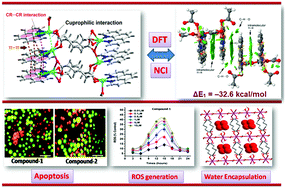Adipato bridged novel hexanuclear Cu(ii) and polymeric Co(ii) coordination compounds involving cooperative supramolecular assemblies and encapsulated guest water clusters in a square grid host: antiproliferative evaluation and theoretical studies†
Abstract
Two new coordination compounds involving hexanuclear Cu(II), viz., [Cu6(phen)6(μ4-adpt)4(H2O)2](NO3)4·10H2O (1) and polymeric Co(II), viz., {[(μ2-adpt)4Co(μ2-H2O)2Co(H2O)4]·4H2O}n (2) (phen = 1,10-phenanthroline; adpt = adipate) have been synthesized and characterized using elemental analysis, TGA, spectroscopic (IR, electronic and ESR), PXRD and single crystal X-ray diffraction techniques. Discrete nitrate-water clusters involving the [(H2O)3NO3]− core in 1 and linear (H2O)4 core in 2 provide stability to the layered network of the structures of the compounds. Interestingly, the water clusters in polymer 2 are encapsulated as guests in the voids of the host square grid that extends in 2D architecture. Theoretical studies have revealed the presence of interesting energetically significant cooperativity effects of π-stacking contacts that are responsible for the hexanuclear structure of compound 1. Both complexes significantly inhibit cell viability by inducing apoptotic cell death in the DL cancer cell line with negligible cytotoxicity in normal cells (PBMC). An assessment of ROS (reactive oxygen species) level study revealed a rapid increase of ROS in DL cells indicating cytotoxicity of the compounds against the DL cells. A decrease in MMP (mitochondrial membrane potential) is associated with an opening of the mitochondrial permeability transition pores which corroborates the apoptotic features of 1 and 2. The mode of action of the cytotoxic activities of the compounds has been explored with respect to their in silico docking ability and further inhibition of antiapoptotic proteins as evidenced by western blot analysis. SAR analyses based on pharmacophore modelling reveal that the molecular features of the structures of the compounds play important roles in biological activities.



 Please wait while we load your content...
Please wait while we load your content...